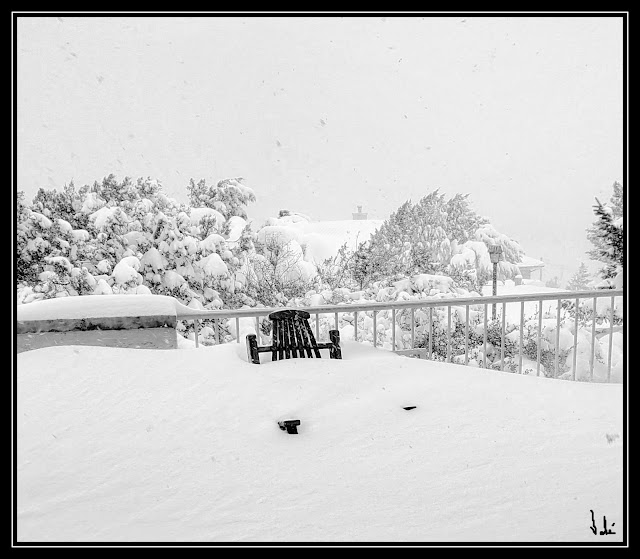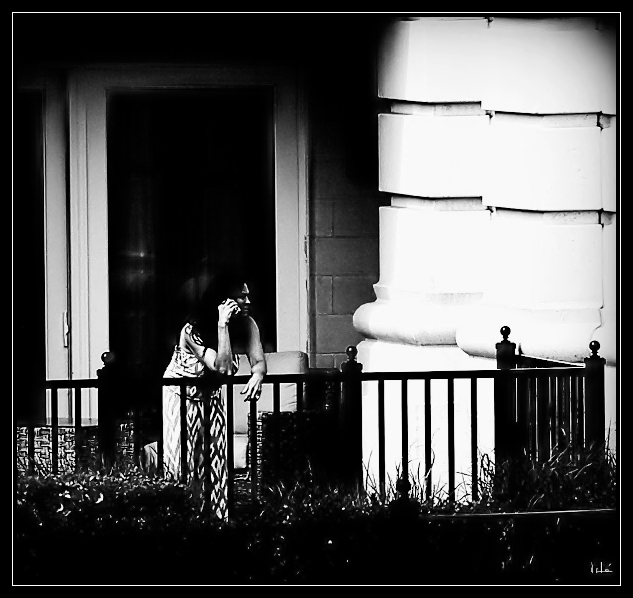It has been a massive storm now covering Northern Arizona’s high country where mountain ranges of the high desert go from 5,000 feet altitude to close to 7,000 feet. Almost 3 feet of snow fell in the past 24 hours transforming the desert topography to Nordic scenery.
I was not sure what to expect so in optimism and anticipation, I loaded my 1970s Soviet Salyut medium format camera with B&W film. Unfortunately the sun has been covered for two days now and, if I carry the 4 pound monster camera outside, the 25 mile/hour winds would fill my old “light box” with snow in a minute!
So, I was watching the storm from a window overlooking the balcony. One of the rocking chairs started to be filled with snow and stopped rocking alone at the wind.
My immediate reaction was that it was a sad chair. Lonesome and cold.
And that, somehow, reminded me of a poem by Jane Hirshfield titled “Chair in Snow” I had read many years ago online. Then, I had thought it was a tangible metaphor most people would identify with except perhaps the Bushmen of the Kalahari Desert!
So, I found that poem online(1) and read it again.
…“and yet a chair in
snow is always sad
more than a bed
more than a hat or
house
a chair is shaped for
just one thing”
I stopped for a minute. What was that “one thing” for me?
Clearly a chair is for humans, although cats and dogs often make a chair their own. A chair is shaped in many ways, some inviting like a dulcet bed, others requiring uncomfortable acrobatics to use. But the purpose is often the same – to settle for a moment.
However, not everyone can settle down or in. My favorite summary of this character trait is by André Gide, Nobel Prize 1947:
Never have I been able
to settle in life. Always seated askew, as if on the arm of a chair; ready to
get up, to leave.
And leave he did. He left norms and some literary traditions behind to become the most famous French writer in the 1930s and 40s. In his words:
"Man cannot discover new oceans unless he has the courage
to lose sight of the shore.".
So, a chair has to be matched to a person's character. A true character I recall from the sports world, cricket more specifically, was the New Zealander Glenn Turner. He put it simply:
"Worrying is like a rocking chair, it gives you something to do but it gets you nowhere”
Of course, all Turner thought about while playing cricket was to hit the ball and run between the wickets to make it to the other end without a fielder hitting the wickets with that ball. He did not seem to have been the type to worry too much – just run.
…I looked at the chair again. The storm had dumped (or the wind had moved around) much more snow leaving only half of the rocking chair visible. At this point it seemed that snow was sitting in the chair with a "snow arm" on the left arm of the chair. It was a strange sight and I took a couple of photos with the Salyut.
Why?
Why would one take a photo of a chair “filled” with snow?
Perhaps because of what Andy Warhol once typically said:
“You would not believe
how many people will hang up a picture of an electric chair, especially if it
matches the colour of their curtains”
Ha!
So, after my own musing about Hirshfield’s idea as to that one thing a chair is shaped for, I continued reading her poem:
… “to hold
a soul its quick and
few bendable
hours
perhaps a king
not to hold snow
not to hold flowers”
… My chair was now holding snow, and letting the wind blow parts of it away. The snow made my chair happy; its sadness seemed to fly away with the cold wind.
I thought it was a good thing to happen to a lonesome rocking chair. And it made me smile on this gloomy day. Maybe even made me happy like Albert Einstein suggested:
“A table, a chair, a
bowl of fruit and a violin; what else does a man need to be happy?”
Nothing really. Or perhaps a warm blanket for a good night's rest in that chair.
January 25, 2021
© Vahé A. Kazandjian, 2021
(1)https://silverbirchpress.wordpress.com/2014/02/26/a-chair-in-snow-poem-by-jane-hirshfield/





